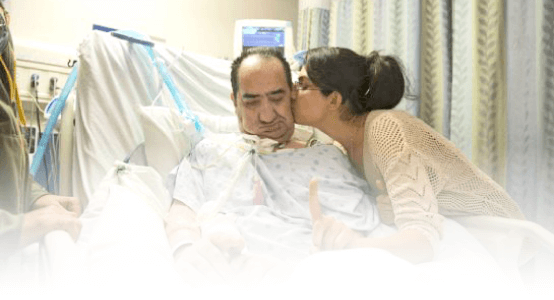Podcast: Play in new window | Download
Subscribe: Apple Podcasts | RSS
Hi, it’s Patrik Hutzel from INTENSIVECAREHOTLINE.COM , where we instantly improve the lives of Families of critically ill Patients in Intensive Care, so that you can have PEACE OF MIND, real power, real control and so that you can influence decision making fast, even if you’re not a doctor or a nurse in Intensive Care!
This is another episode of “YOUR QUESTIONS ANSWERED” and in last week’s episode I answered one of our reader’s question
You can read, watch or listen to this question here.
In this week’s episode of “YOUR QUESTIONS ANSWERED” I want to answer another question that our readers ask on a regular basis and the question is
“WHY DO DOCTORS IN INTENSIVE CARE INSERT A TRACHEOSTOMY AFTER AN INDUCED COMA?”
Ventilation and the Induced Coma and what might lead to it
If your loved one has been admitted to Intensive Care for critical illness and if your critically ill loved one has been in an induced coma for any length of time and hasn’t woken up or hasn’t come out of the induced coma as yet and is still dependent on the ventilator/ respirator you may have asked yourself what might be next? And you may have also heard the Intensive Care team making suggestions of what might be next, if your critically ill loved one hasn’t woken up from the induced coma as yet.
Inducing your critically ill loved one into a coma in Intensive Care is often the only way to treat the underlying disease or illness that brought your loved one into Intensive Care in the first place. This usually goes hand in hand with mechanical ventilation and a breathing tube.
The admission scenarios that led to your critically ill loved one coming to Intensive Care, getting induced into a coma for mechanical ventilation with a breathing tube, can range from Poly or multitrauma, brain or head injuries, to many types of surgery including Open heart surgery, Triple A repair or Aneurysm repair, Sepsis, Stroke, Seizures, Asthma, COPD, Heart Attack, lung or heart transplant, Pneumonia and the list goes on…
Sedatives and opiates(pain medication) keeping your loved one in the induced coma are not the long-term answer and cure
Sometimes the induced coma is necessary for a few days and as a rule of thumb, the longer your critically ill loved one stays in the induced coma, the higher the risk that your loved one is getting weaker and therefore a weaning off the ventilator may become increasingly difficult.
The other risk that your critically ill loved one is facing when getting induced into a coma is that “waking up” out of the induced coma may sometimes be delayed and/or not “straight forward”, because during the induced coma your critically ill loved one has been heavily sedated with sedatives and opiates(pain medication) such as Propofol, Midazolam(Dormicum or Hypnovel), Fentanyl or Morphine, to name but a few of the drugs.
Here are some of the reasons why “waking up” may not be straight forward
These sedatives and opiates are very effective when it comes to keeping your critically ill loved one in the induced coma. They are less effective and even detrimental when it comes to your critically ill loved one coming out or “waking up” from the induced coma. The more sedatives and opiates(pain medication) have been used during the induced coma and the longer your critically ill loved one is kept in the induced coma, the higher the risk that your loved one “waking up” and getting weaned off the ventilator gets delayed and more and more difficult.
Other risk factors that delay “waking up” and weaning off the ventilator are things such as
- Head or brain injuries
- Polytrauma or multitrauma
- Seizures
- Stroke
- Hypoxic brain injury
- Kidney failure(if the kidneys fail, drugs accumulate in the body system and are difficult to be cleared by the kidneys)
- Liver failure(similar to kidney failure)
- Generally speaking, with increasing age, coming out of an induced coma gets more difficult
A Tracheostomy might be the next step
If in any of the scenarios mentioned above, where your critically ill loved one has been removed from the sedation and the opiates and in theory your loved one should come out of the induced coma, breathe by themselves and be taken off the ventilator and things don’t go as planned and your critically ill loved one is only waking up slowly or not at all and therefore taking your critically ill loved one off the ventilator is getting delayed and difficult, that’s usually the time when the Intensive Care team mentions that performing a Tracheostomy might be the next step.
The reason why a Tracheostomy might be the treatment of choice and in your loved one’s best interest is that with a Tracheostomy in place, usually sedation and opiates(pain medication) can be minimized or completely removed. With the breathing tube in your critically ill loved one’s mouth, you may have already sensed that this is extremely uncomfortable and requires some sort of sedation and opiates(pain medication) in order for your critically ill loved one to tolerate the breathing tube and the ventilator.
With a Tracheostomy in place, sedation and opiates can be either completely removed or at least minimized and breathing on a ventilator/respirator is so much easier to tolerate for your critically ill loved one.
Now, “waking up” and weaning off the ventilator might be a much more achievable goal
Furthermore, because your critically ill loved one has now been taken off the sedation and the opiates or at least they have been minimized, it’s so much easier for the Intensive Care team to assess your critically ill loved one whether he or she is “waking up”.
Moreover, now that your critically ill loved one has a Tracheostomy, he or she can be taken off the ventilator and breathe via an oxygen mask or via a Tracheostomy mask without the ventilator. This usually is a gradual process, where after the Tracheostomy has been performed, your critically ill loved one can be taken off the ventilator for a few hours and then breathe with the ventilator/ respirator again. This step by step process, with the goal to gradually wean your loved one off the ventilator/ respirator is so much easier to achieve with a Tracheostomy, compared to the breathing tube in your loved one’s mouth.
A Tracheostomy generally doesn’t cause much pain and discomfort and your loved one should be able to speak as well
The Tracheostomy generally speaking doesn’t cause much pain and discomfort, whereas as you might have seen already, the breathing tube in your loved one’s mouth is very hard to tolerate and is just uncomfortable.
Furthermore, especially when it comes to prolonged stays in Intensive Care and if your critically ill loved one is still at a point where he or she is still unstable and if your critically ill loved one might face breathing issues, the Tracheostomy has shown to be much more Patient friendly compared to the breathing tube through the mouth.
Another secondary “pay-off” and advantage for your critically ill loved one is that when your loved one has time off the ventilator and is able to breathe with oxygen only, the Intensive Care team should be able to insert a “speaking valve”, where your critically ill loved one should be able to speak. Ask the Intensive Care team if that’s a possibility and keep pushing and asking for it.
Some related articles that you also might want to check out:
- How long can a breathing tube or an endotracheal tube can stay in?
- Tracheostomy and weaning off the ventilator in Intensive Care, how long can it take?
How can you leverage your level of power, influence and control whilst your loved one is critically ill in Intensive Care?
You’ll get to that all important feeling of power, control and influence when you download your FREE “INSTANT IMPACT” report NOW by entering your email below! In Your FREE “INSTANT IMPACT” report you’ll learn quickly how to get real power and real control and how you can influence decision making fast, whilst your loved one is critically ill in Intensive Care! Our FREE reports help you with in-depth insight that you must know whilst your loved one is critically ill or is dying in Intensive Care! Sign up for your FREE membership and download your FREE “INSTANT IMPACT” REPORT now!
In your FREE “INSTANT IMPACT” REPORT you’ll learn how to speak the “secret” Intensive Care language so that the doctors and the nurses know straight away that you are an insider and that you know and understand what’s really happening in Intensive Care!
In your FREE report you’ll also discover
- How to ask the doctors and the nurses the right questions
- Discover the many competing interests in Intensive Care and how your critically ill loved one’s treatment may depend on those competing interests
- How to eliminate fear, frustration, stress, struggle and vulnerability even if your loved one is dying
- 5 “killer” tips& strategies helping you to get on the right path to PEACE OF MIND, control, power and influence in your situation
- You’ll get real world examples that you can easily adapt to your and your critically ill loved one’s situation
- How to stop being intimidated by the Intensive Care team and how you will be seen as equals
- You’ll get crucial ‘behind the scenes’ insight so that you know and understand what is really happening in Intensive Care
- How you need to manage doctors and nurses in Intensive Care(it’s not what you think)
Thank you for tuning into this week’s episode of “your questions answered” and I’ll see you again in another update next week! Make sure you also check out our “blog” section for more tips and strategies or send me an email to [email protected] with your questions!
Also check out our Products section where you get more Ebooks, Videos and Audio recordings and where you can also get 1:1 consulting!
This is Patrik Hutzel from INTENSIVECAREHOTLINE.COM and I’ll see you again next week with another update!
Sincerely, your Friend
Patrik Hutzel
Related Articles:


